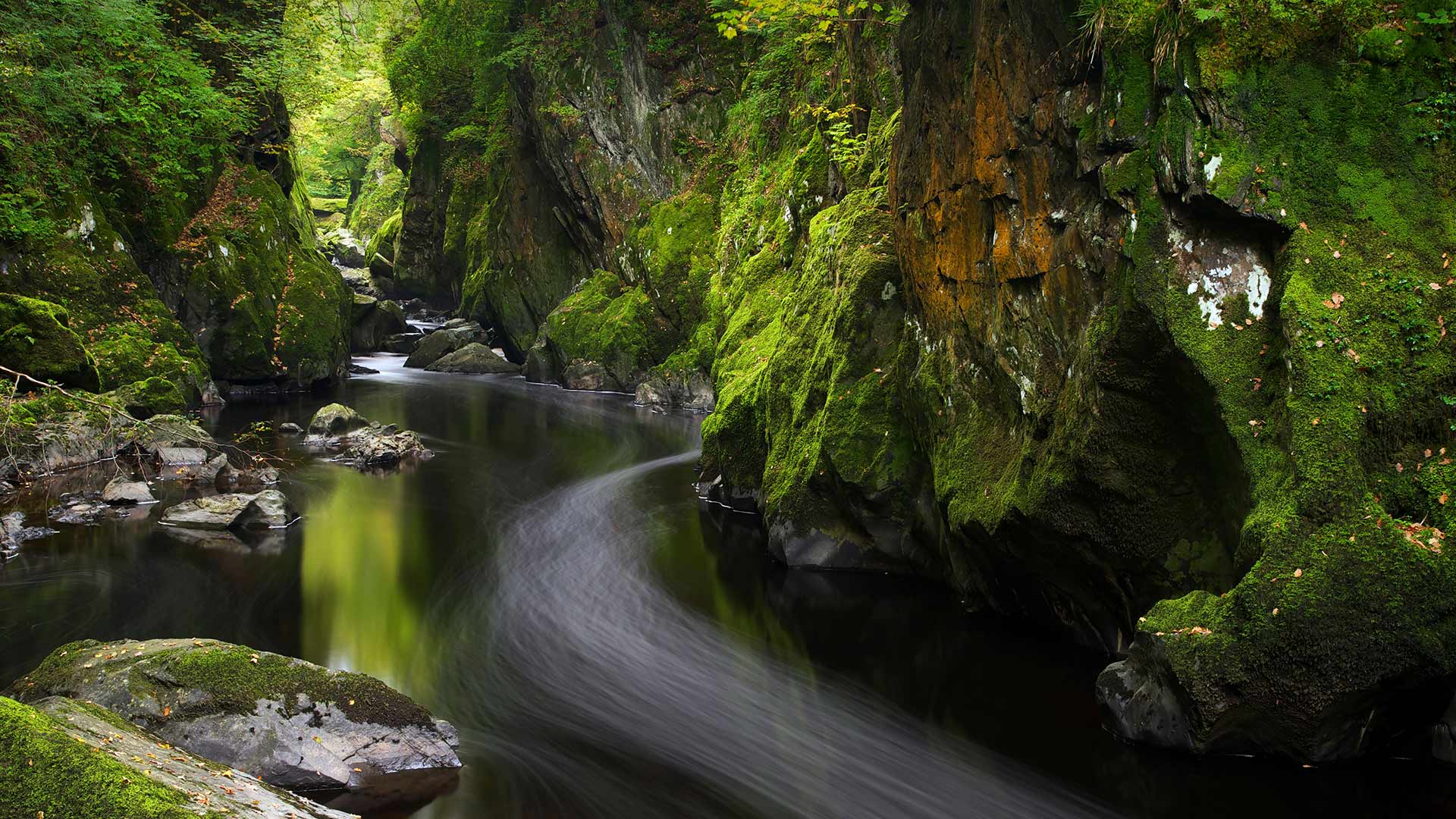从冰山跃入水中的阿德利企鹅,南极 Adélie penguins diving off an iceberg in Antarctica (© Mike Hill/Getty Images)
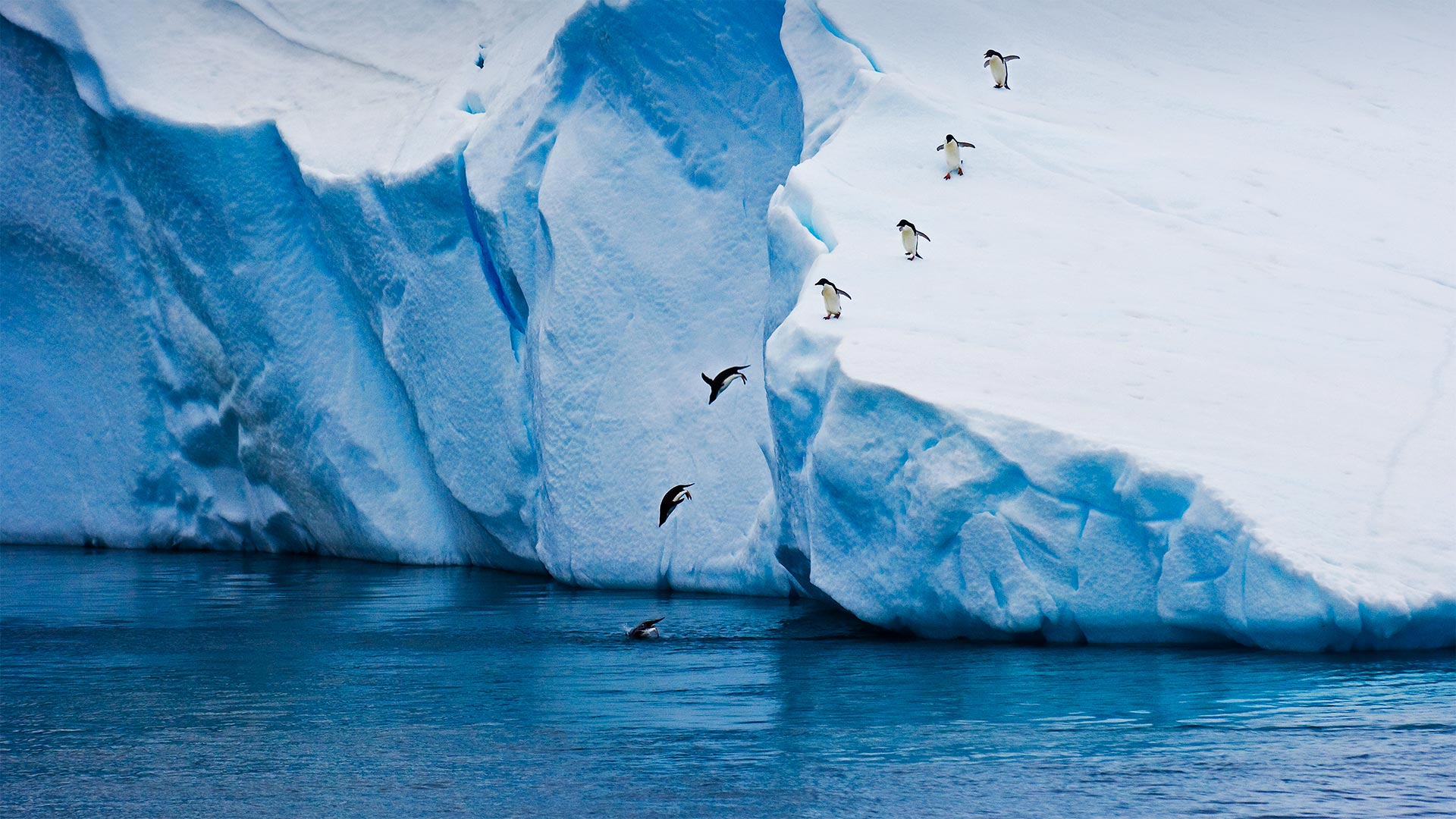
从冰山跃入水中的阿德利企鹅,南极 Adélie penguins diving off an iceberg in Antarctica (© Mike Hill/Getty Images)
One giant leap for penguins
These Adélie penguins are jumping for joy because it's World Penguin Day. Or maybe they're just looking for a snack as they dive off this iceberg. Adélies live on Antarctica and nearby islands all year long, but in the fall and winter they spend most of their time near the coast. They can dive as deep as 575 feet or travel as much as 185 miles to find krill, fish, and squid.
The smallest penguin in the Antarctic, Adélies are one of only two penguin species (the other is the Emperor penguin) that live exclusively on the Antarctic continent. Huge colonies of Adélies were once spread throughout the Antarctic Peninsula and the coastline of the continent, but as climate change took hold, populations declined in some areas. Fortunately, a robust colony of some 1.5 million Adelie penguins was found on the Antarctic Peninsula's Danger Islands.
企鹅的一次大跃进
这些广告é因为今天是世界企鹅日,所以企鹅们高兴得跳起来。或者他们只是在从冰山上跳下去的时候找点吃的。广告é它们终年生活在南极洲和附近的岛屿上,但在秋天和冬天,它们大部分时间都在海岸附近。它们可以潜到575英尺深或185英里深的地方寻找磷虾、鱼和鱿鱼。
南极最小的企鹅,公元é谎言是只生活在南极大陆的两种企鹅物种之一(另一种是帝企鹅)。大量的广告é谎言一度蔓延到整个南极半岛和该大陆的海岸线,但随着气候变化,一些地区的人口减少。幸运的是,在南极半岛的危险岛上发现了一个由大约150万只阿德利企鹅组成的健壮的群体。
Casa Batlló in Barcelona, Catalonia, Spain 巴特洛公寓, 在巴塞罗那, 加泰罗尼亚, 西班牙 (© Marco Arduino/Sime/eStock Photo)
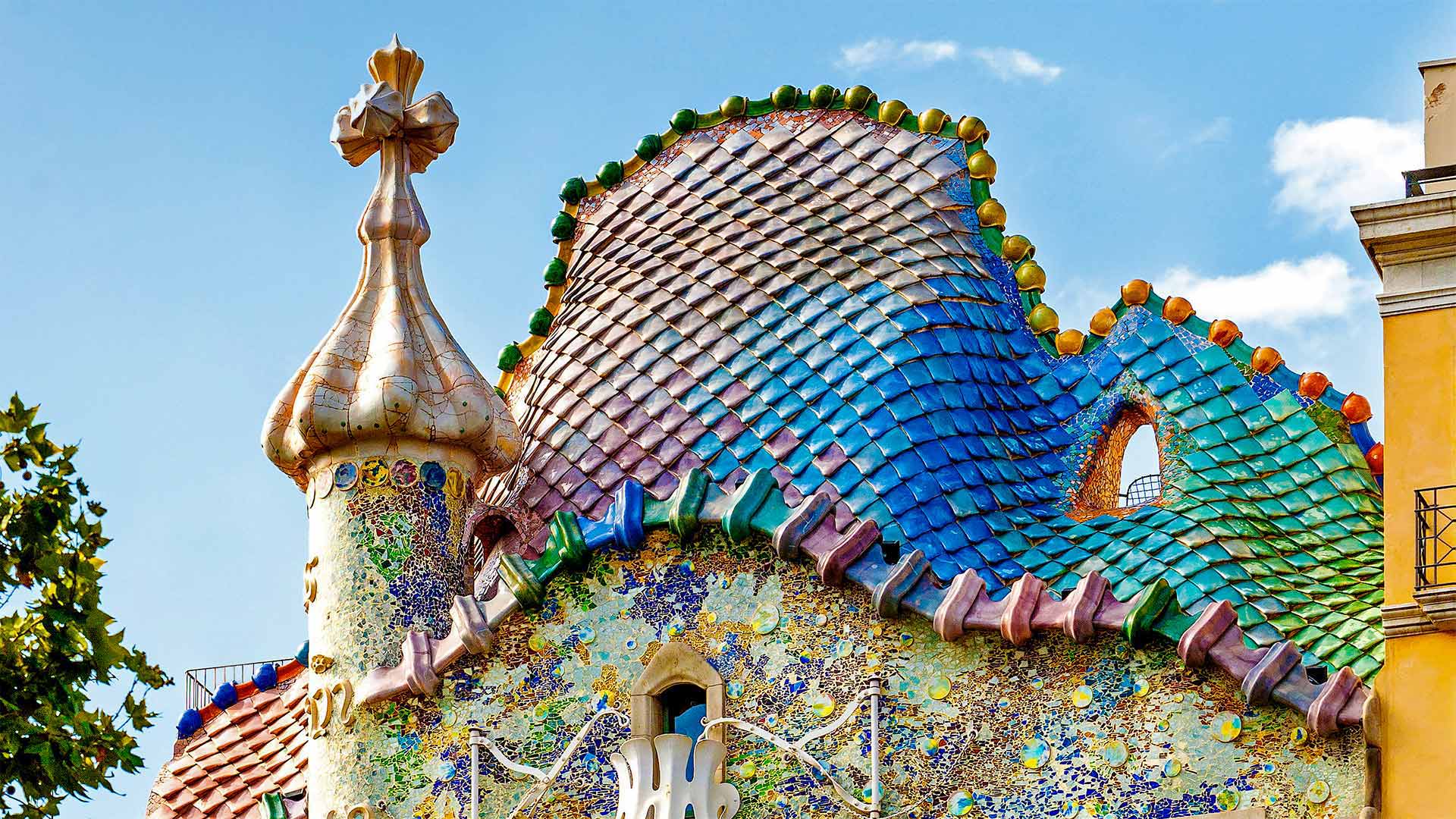
Casa Batlló in Barcelona, Catalonia, Spain 巴特洛公寓, 在巴塞罗那, 加泰罗尼亚, 西班牙 (© Marco Arduino/Sime/eStock Photo)
A house of grand scale(s)
We're looking at the rooftop of Casa Batlló, a 6-story building in the center of Barcelona topped with colorful 'scales.' What brings us here? Well, here in Spain's province of Catalonia, and in several other locales from England to Ethiopia, it's the feast of Saint George. You know George (or Jordi, as the Catalans call him): He's the knight who, legend holds, saved a much-loved princess by defeating a fierce dragon. It's said the tower jutting from the Casa's tiled roof represents George's lance thrust into the monster's scaly back.
George is Catalonia's patron saint—but the designer of Casa Batlló's façade could be called the land's patron architect. Antoni Gaudí designed dozens of buildings around Barcelona in matching fashion: bold fairy-tale designs with curvy constructions and vibrant colors. Gaudí's long-unfinished masterpiece, the famous Sagrada Família cathedral, is set to be completed in 2026, a century after his passing.
大房子
我们在看Casa Batll的屋顶ó, 巴塞罗那市中心的一座6层楼高的建筑,上面有五颜六色的“鳞片”。什么风把我们吹来了?嗯,在西班牙的加泰罗尼亚省,以及从英国到埃塞俄比亚的其他几个地方,这是圣乔治的盛宴。你知道乔治(或者加泰罗尼亚人叫他乔迪):传说中,他是一位骑士,他打败了一条凶猛的龙,拯救了一位深受爱戴的公主。据说这座塔从木屋的瓦片屋顶伸出,代表着乔治的长矛插进了怪物鳞片般的背部。
乔治是加泰罗尼亚的守护神,但卡萨巴特尔的设计师ó's fa公司ç艾德可以被称为这片土地的赞助人建筑师。安东尼·高德í 在巴塞罗那周围设计了几十座建筑,风格搭配:大胆的童话设计,弯曲的结构和鲜艳的色彩。高德í'他的长篇未完成的杰作,著名的萨格拉达家族í在他去世一个世纪后,西伯利亚大教堂将于2026年竣工。
贝图瑟科伊德的Fairy Glen,英国威尔士 (© Robert Harding World Imagery/Offset by Shutterstock)
位于阿肯色州和密西西比州交界处的密西西比河 Mississippi River on the border between Arkansas and Mississippi (© NASA)
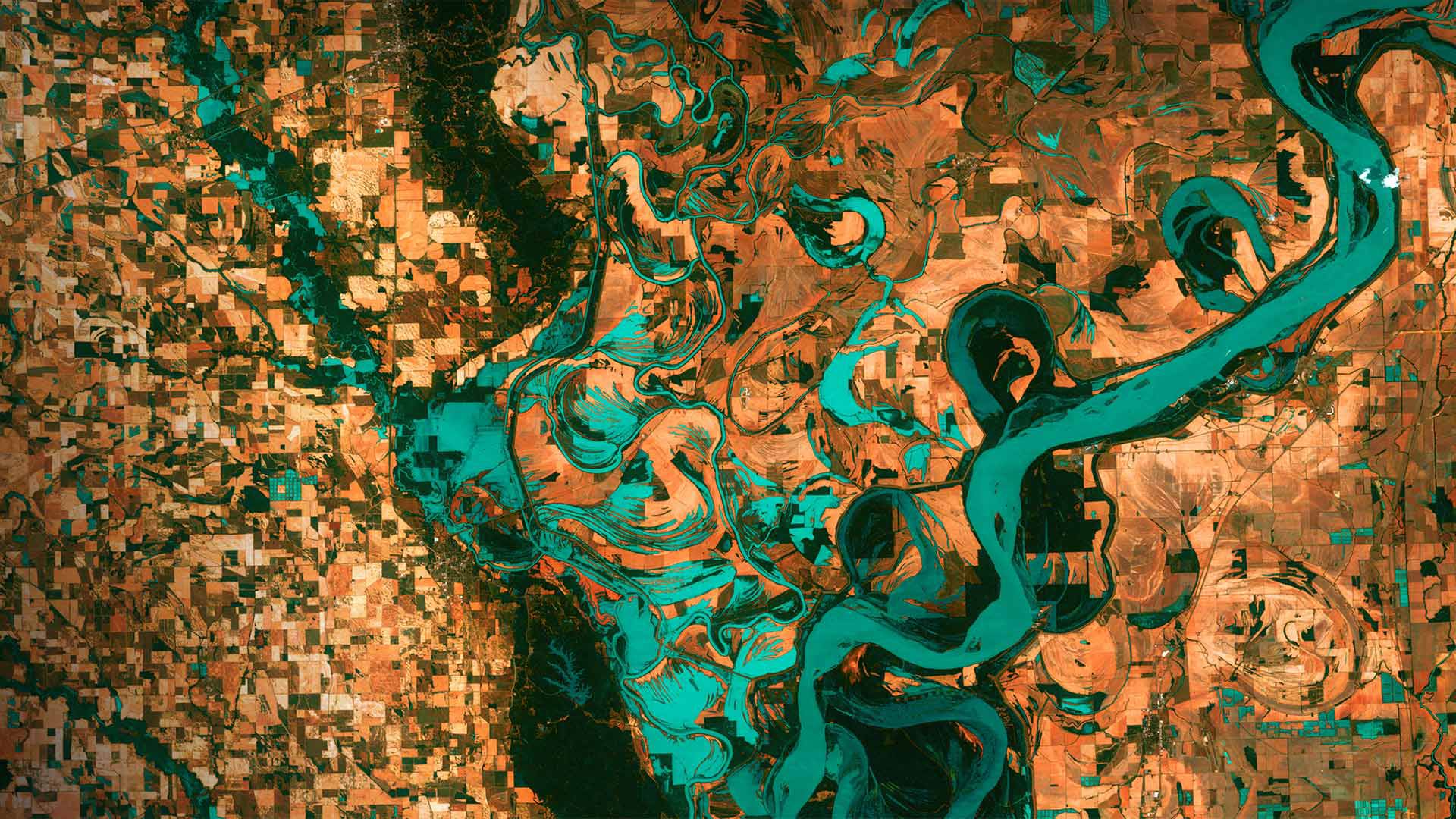
位于阿肯色州和密西西比州交界处的密西西比河 Mississippi River on the border between Arkansas and Mississippi (© NASA)
Gazing down on planet Earth
It's Earth Day today and we are high above the blue marble looking down on the border between Arkansas and Mississippi. Those small, blocky shapes are towns, fields, and pastures–the teal green is the mighty Mississippi River. Anyone who has flown in the window seat of an airplane and has gazed down at Earth below might wonder why the colors in this image are so unreal. That's because they are. These images were taken in 2013 by Landsat 7, a NASA satellite that uses thermal infrared sensors to help scientists better distinguish flora, fauna, water, and manmade objects. For almost 50 years, NASA has been using satellite imagery to understand how climate change and population growth are affecting our fragile planet. These satellites help NASA see where deforestation and wildfires are happening, where glaciers are melting, and how rising waters are encroaching on cities.
The biggest cause of these changes? According to NASA, it's us. Since the first Landsat launched in 1972, the Earth's population has almost doubled, from 4 billion people then to 7.8 billion today. But there is some good news to mark this Earth Day: The Mississippi River we see here is much less toxic now than it was back in 1972, thanks to environmental laws and regulations.
俯瞰地球
今天是地球日,我们在阿肯色州和密西西比州交界处的蓝色大理石上方俯瞰。那些小而块状的形状是城镇、田野和牧场——青绿色是浩瀚的密西西比河。任何坐过飞机靠窗座位的人,都可能会想,为什么这张照片中的颜色如此不真实。那是因为他们是。这些图像是2013年由美国宇航局的陆地卫星7号拍摄的,该卫星使用热红外传感器帮助科学家更好地区分动植物、水和人造物体。近50年来,美国宇航局一直在利用卫星图像来了解气候变化和人口增长是如何影响我们这个脆弱的星球的。这些卫星有助于美国宇航局了解森林砍伐和野火正在发生的地方,冰川正在融化的地方,以及上涨的海水如何侵蚀城市。
这些变化的最大原因是什么?据美国宇航局说,是我们。自从1972年第一颗陆地卫星发射以来,地球人口几乎翻了一番,从当时的40亿人增加到今天的78亿人。但是,有一些好消息值得纪念这个地球日:由于环境法律和法规,我们在这里看到的密西西比河现在的毒性比1972年时要小得多。
马德拉岛的北海岸,葡萄牙 The north coast of Madeira, Portugal (© Hemis/Alamy)
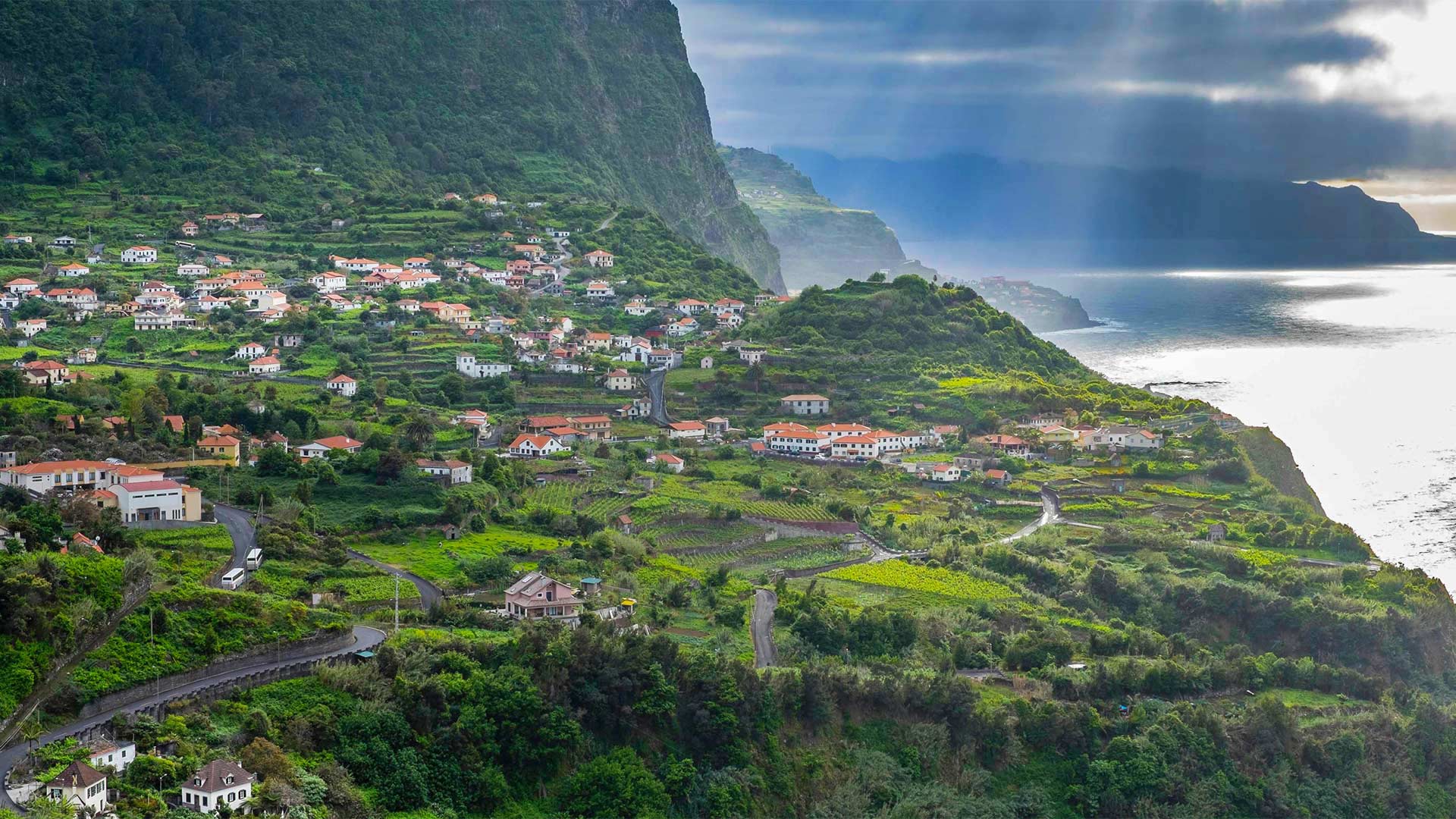
马德拉岛的北海岸,葡萄牙 The north coast of Madeira, Portugal (© Hemis/Alamy)
Exploring the 'Pearl of the Atlantic'
We're taking a view of the island of Madeira, by far the largest island in the Madeira archipelago, which sits 320 miles off the coast of Morocco in the North Atlantic. Part of an autonomous region of Portugal, Madeira, known as the 'Pearl of the Atlantic,' boasts a diverse forest ecosystem, endemic flora and fauna, and the largest living stand of laurel trees in the world. It's a great place to hike, too. Trails run alongside irrigation channels, called levadas, that move water all over the island. Walks range from easy strolls in the countryside to precarious hikes along mountain ridges or into remote parts of the forests. Afterward, the calorie-depleted can dig into a local delicacy like peixe espada com banana (fried local fish with banana) and sip on Madeira wine. Saúde!
探索“大西洋明珠”
我们正在观看马德拉岛,这是迄今为止马德拉群岛中最大的岛屿,位于北大西洋摩洛哥海岸320英里外。作为葡萄牙自治区的一部分,被称为“大西洋明珠”的马德拉拥有多样化的森林生态系统、特有的动植物群和世界上最大的活月桂林。这也是徒步旅行的好地方。小径沿着被称为levadas的灌溉渠延伸,这些灌溉渠将水输送到全岛。散步的范围从乡村的轻松漫步到沿着山脊或进入森林偏远地区的危险徒步旅行。之后,消耗掉的热量可以吃到当地的美味,比如peixe espada com香蕉(用香蕉炸当地鱼),然后啜饮马德拉葡萄酒。萨乌德!
乌布德格拉朗梯田,印度尼西亚巴厘岛 Tegalalang Rice Terraces, Ubud, Bali, Indonesia (© Michele Falzone/Alamy)
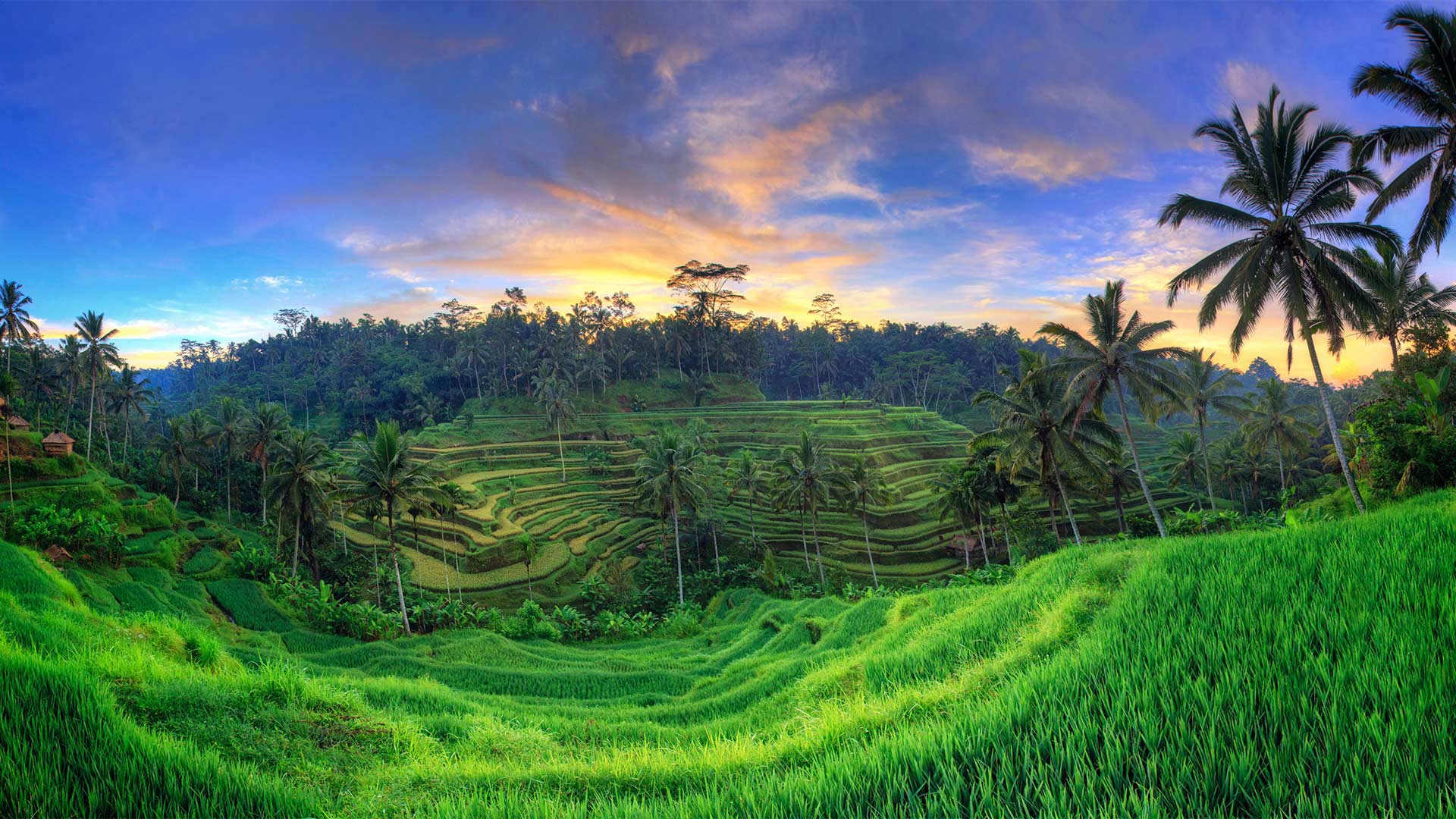
乌布德格拉朗梯田,印度尼西亚巴厘岛 Tegalalang Rice Terraces, Ubud, Bali, Indonesia (© Michele Falzone/Alamy)
Terraced fields of green
Twice a year, all of Bali, Indonesia—including those who live and work in the lush, green rice terraces you see here—join together to celebrate the country's most important holiday, Galungan. This 10-day Balinese-Hindu milestone always comes at the end of the traditional 210-day Balinese calendar, usually in March or April, and then again in September or October.
This spring, the festivities began on April 14, and on that day the Balinese invited the spirits of their ancient ancestors into their homes with prayers and other offerings draped from bamboo poles called penjor, which seem to be erected everywhere. Planted in the ground at individual homes or along the sides of roads and decorated with coconut leaves and flowers, penjor are used to hang offerings as a kind gesture towards the spirits. The tenth and final day of Galungan is called Kuningan, which comes on April 24 this year. To mark this finale, a specially prepared yellow rice will be offered to the departing ancestors, a gift to accompany them on their return journey to the spirit world.
绿色梯田
每年两次,印度尼西亚巴厘岛—包括那些住在这里绿油的梯田里生活和工作的人—一起庆祝这个国家最重要的节日,加尔隆根。这10天的巴厘印度教里程碑总是在传统的210天巴厘历的结束,通常是在3月或4月,然后在9月或10月再次出现。
今年春天,节日从4月14日开始,那天巴厘人邀请他们古老祖先的灵魂们到他们的家里,祈祷和其他祭品都是用竹竿做成的,这些竹竿上挂着,这些祭品似乎到处都是竖立的。彭若尔种植在单独的家里或道路的两侧,用椰子叶和鲜花装饰,用来悬挂祭品,作为对灵魂的一种亲切的姿态。高龙根的第十天也是最后一天,叫做昆ingan,今年4月24日。为了纪念这一结局,将向离世的祖先赠送一份特制的黄米,作为陪伴他们返回精神世界的礼物。
大群的芒基蝠鲼跃出水面,墨西哥加利福尼亚湾 Large school of Munk's pygmy devil rays from the air, Gulf of California, Mexico (© Mark Carwardine/Minden Pictures)
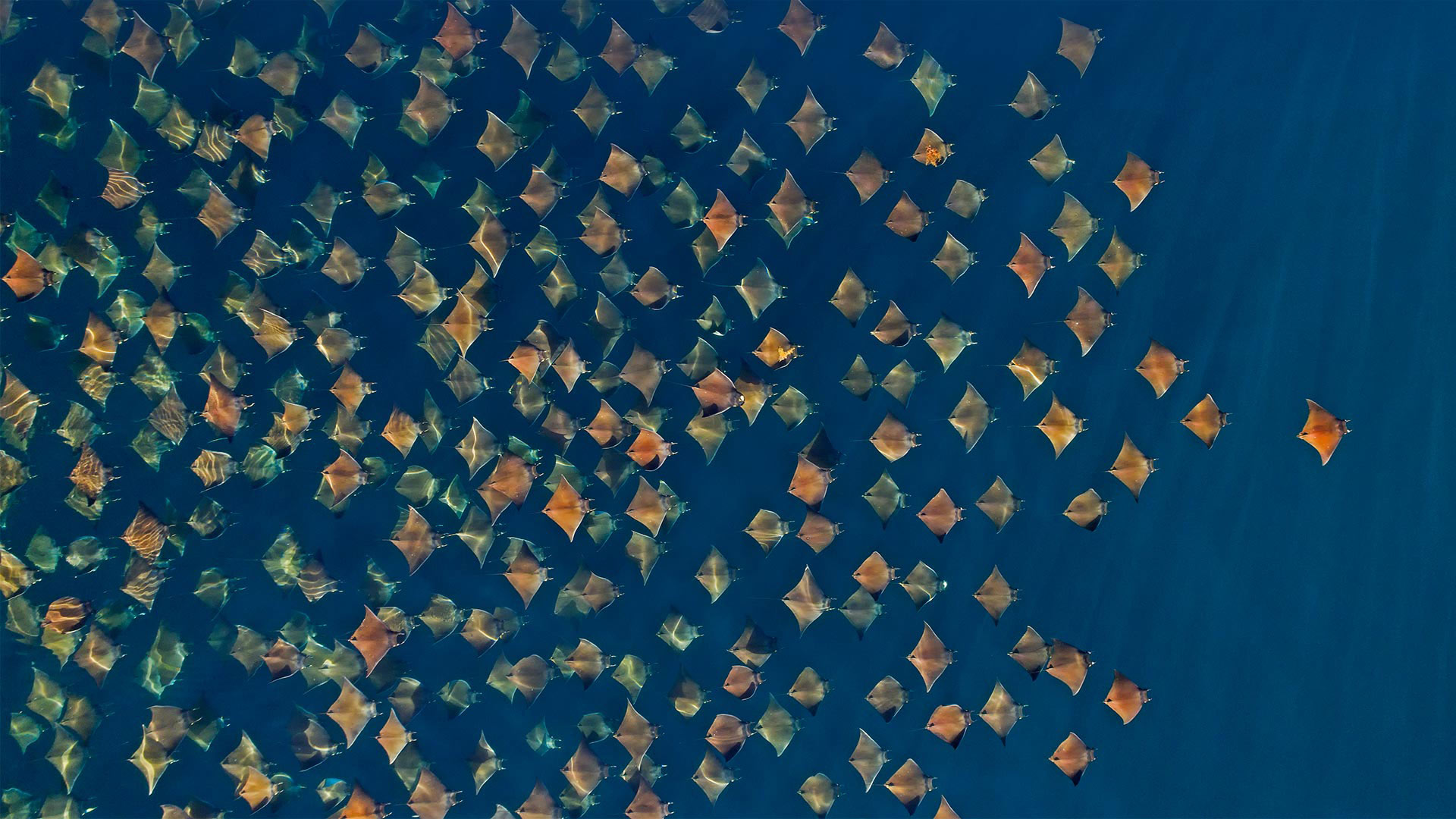
大群的芒基蝠鲼跃出水面,墨西哥加利福尼亚湾 Large school of Munk's pygmy devil rays from the air, Gulf of California, Mexico (© Mark Carwardine/Minden Pictures)
Rays on parade
The feeding frenzy is on! Each spring and fall, the waters off Mexico's Baja California peninsula become the perfect place to spot Munk's devil rays in massive schools like this one. Unlike stingrays (and perhaps the devil), devil rays lack fearsome pointy tails. In fact, these giants—whose wingspans can reach about 9 feet—are pretty gentle all around, feeding mainly on plankton. And for them, mealtime is party time: During huge devil ray gatherings like this, rays are seen continually bursting out of the water and landing with loud bellyflops.
射线在游行
喂食狂潮开始了!每年春天和秋天,墨西哥下加利福尼亚半岛附近的水域都会成为在像这样的大型学校里发现芒克魔鬼鱼的最佳地点。不像黄貂鱼(也许还有魔鬼),魔鬼鱼没有可怕的尖尾巴。事实上,这些翼展能达到9英尺左右的巨型生物四周都很温和,主要以浮游生物为食。对他们来说,进餐时间是聚会时间:在这样的大型魔鬼鱼聚会上,可以看到鱼不断地从水里迸发出来,并带着响亮的肚脐落地。
蒙塔尔巴诺埃利科纳,意大利西西里岛 Montalbano Elicona, Messina, Sicily, Italy (© Antonino Bartuccio/SOPA Collection/Offset by Shutterstock)
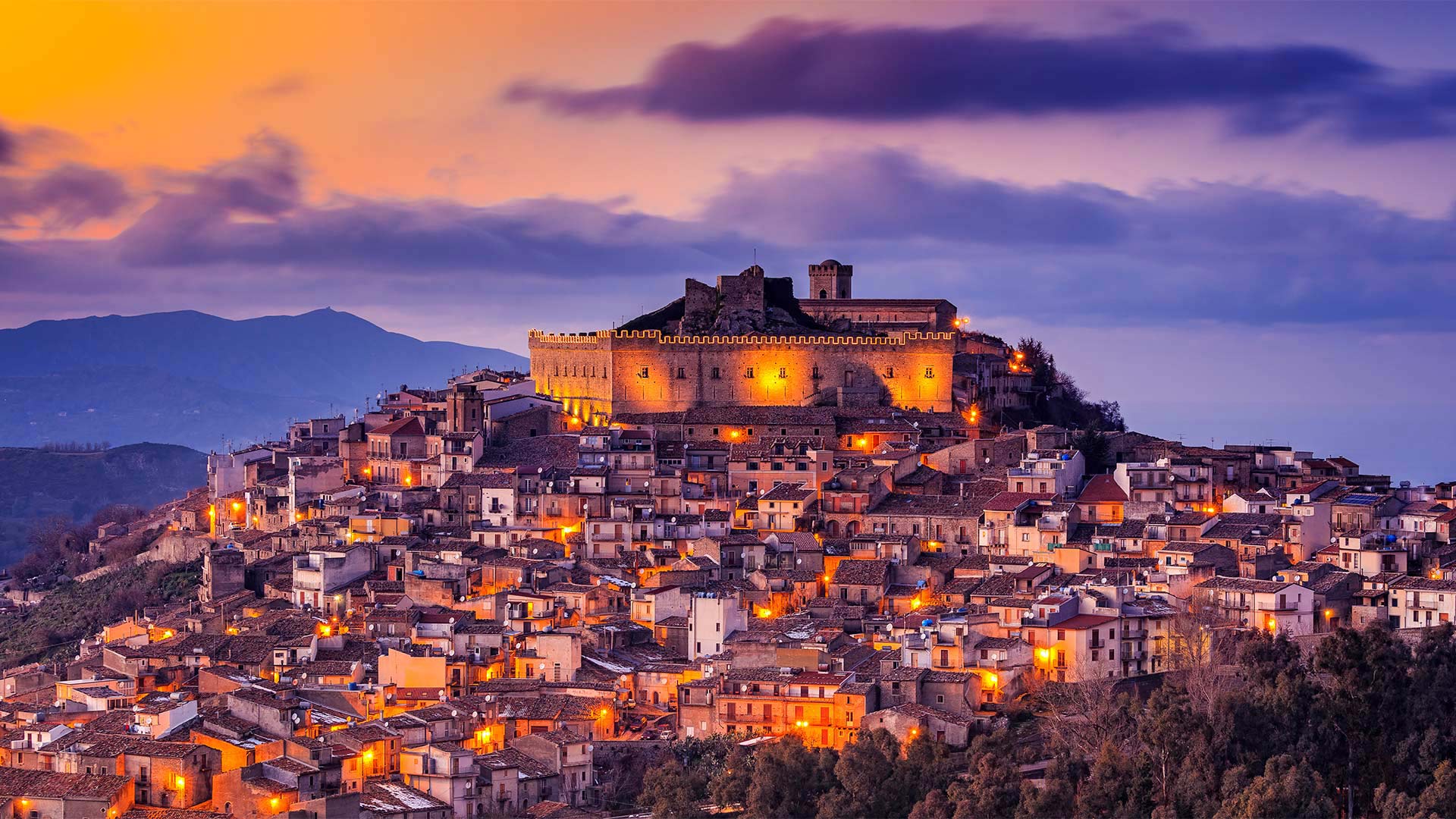
蒙塔尔巴诺埃利科纳,意大利西西里岛 Montalbano Elicona, Messina, Sicily, Italy (© Antonino Bartuccio/SOPA Collection/Offset by Shutterstock)
In Sicily, history is everywhere
Today we're in Montalbano Elicona on the island of Sicily. It's known for the very old castle at the crest of the hill, as well as the quaint medieval village below. It's no wonder that Montalbano Elicona has been called one of the most beautiful towns in all of Italy. The castle itself is believed to have been built in the 13th century by medieval power broker Frederick II of Swabia. He wore many hats, including King of Sicily, Holy Roman Emperor, and—as far-fetched as it sounds—the King of Jerusalem, a title he claimed after conquering that city during the Sixth Crusade. The castle was originally designed as a fortress, but it also served as a summer residence for Frederick and other rulers who followed him.
Surrounding the castle are several other interesting historical sites, including the Church of St. Catherine, known for its Romanesque portal built in the 14th century, its mix of Catalan and renaissance architecture, marble statues of St. Catherine and St. Nicholas Bishop, and a representation of the Last Supper by artist Guido Reni. Also of note is the nearby Argimusco plateau, where an array of large oblong stones, including one which is said to resemble an eagle, have long prompted speculation that they were placed there by members of a prehistoric island culture. However, scientists now believe that these so-called megaliths of Argimusco, sometimes referred to as the Stonehenge of Sicily, are actually of natural origin, and the unique boulder shapes are simply the result of centuries of wind erosion.
在西西里,历史无处不在
今天我们在西西里岛上的蒙塔尔巴诺埃利科纳。它以山顶上非常古老的城堡以及下面古色古香的中世纪村庄而闻名。难怪蒙塔尔巴诺·艾利科纳被称为意大利最美丽的城镇之一。城堡本身被认为是建于13世纪的中世纪权力掮客弗雷德里克二世的斯瓦比亚。他戴着许多帽子,包括神圣罗马皇帝西西里国王,以及听起来很牵强的耶路撒冷国王,这是他在第六次十字军东征中征服耶路撒冷后获得的头衔。这座城堡最初是作为要塞设计的,但它也作为弗雷德里克和其他跟随他的统治者的避暑住所。
城堡周围还有其他一些有趣的历史遗迹,包括圣凯瑟琳教堂(Church of St.Catherine),因其建于14世纪的罗马式大门而闻名,它融合了加泰罗尼亚和文艺复兴时期的建筑,圣凯瑟琳和圣尼古拉斯主教的大理石雕像,以及艺术家吉多·雷尼(Guido Reni)对《最后的晚餐》的描绘。同样值得注意的是附近的阿尔吉穆斯科高原,那里有一排长方形的大石头,其中一块据说像鹰,长期以来一直有人猜测它们是史前岛屿文化的成员放在那里的。然而,科学家们现在认为,这些所谓的阿吉姆斯科巨石,有时被称为西西里巨石阵,实际上是自然起源的,这些独特的巨石形状只是几个世纪风蚀的结果。
新河峡国家公园中的新河峡大桥,西弗吉尼亚州 New River Gorge Bridge in the New River Gorge National Park and Preserve, West Virginia (© Entropy Workshop/iStock/Getty Images Plus)
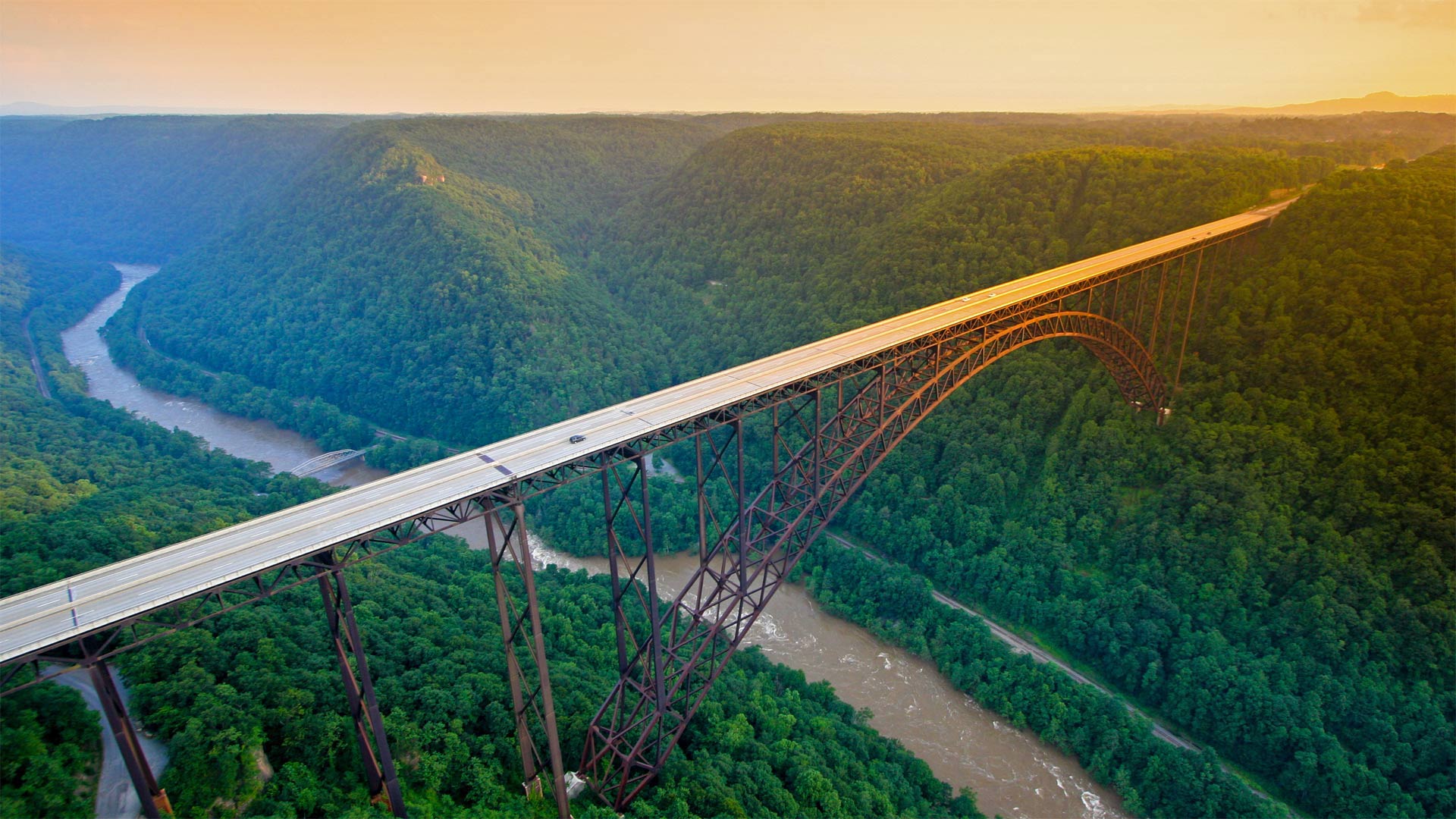
新河峡国家公园中的新河峡大桥,西弗吉尼亚州 New River Gorge Bridge in the New River Gorge National Park and Preserve, West Virginia (© Entropy Workshop/iStock/Getty Images Plus)
A river runs through it
To kick off National Park Week, which begins today, we're visiting America's newest national park, the New River Gorge National Park and Preserve, in West Virginia. This incredible view is of the New River Gorge Bridge, which, when completed in 1977, was the world's highest bridge carrying a regular roadway. It held that distinction for 24 years and is now a popular attraction for BASE jumpers and rappelers.
Far below the bridge is the New River, which—despite its name—is the second oldest river in the world. Its exact age is unknown, but geologists believe the New River is a segment of the preglacial Teays River, which fossil evidence suggests could be 320 million years old. Today, rafters and kayakers come to ride the New River rapids, which can reach a level of Class V, which means they're among the most difficult waters to navigate.
一条河穿过它
为了拉开今天开始的国家公园周的序幕,我们将参观美国最新的国家公园,西弗吉尼亚州的新河峡谷国家公园和保护区。这是令人难以置信的观点是新河峡谷大桥,这是在1977年建成时,世界上最高的桥梁进行定期道路。24年来,它一直保持着这一殊荣,现在已经成为跳垒和饶舌的热门景点。
桥下远处是新河,尽管它的名字是世界上第二古老的河流。它的确切年龄不得而知,但地质学家认为这条新河是前冰期Teays河的一段,化石证据表明这条河可能有3.2亿年的历史。今天,椽子和皮划艇来乘坐新的河流急流,这可以达到五级水平,这意味着他们之间的最困难的水域航行。
菲格雷斯的达利剧院博物馆, 西班牙 Dalí Theatre-Museum in Figueres, Spain (© Valerija Polakovska/Shutterstock)
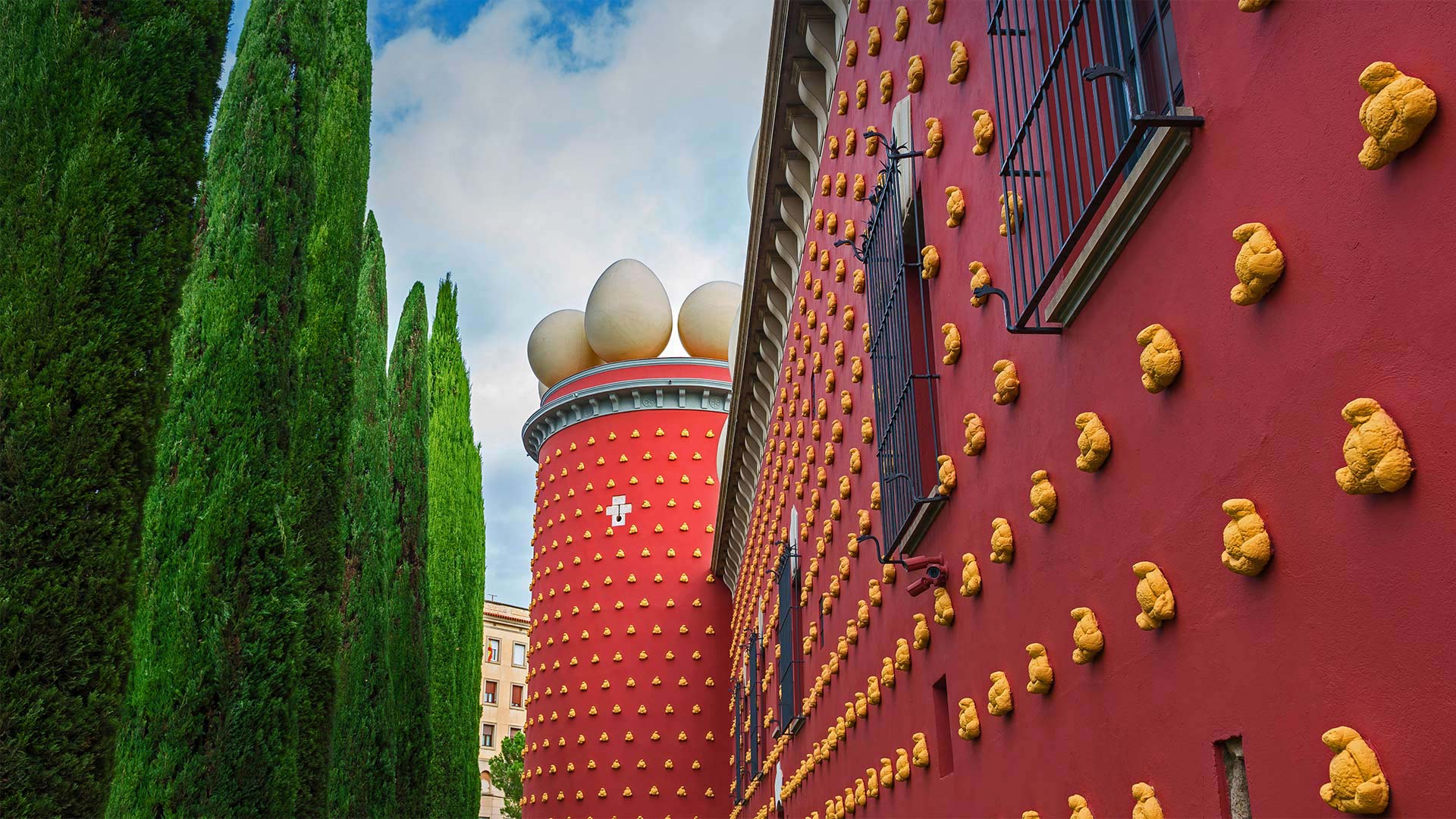
菲格雷斯的达利剧院博物馆, 西班牙 Dalí Theatre-Museum in Figueres, Spain (© Valerija Polakovska/Shutterstock)
'A theatrical dream'
The work of surrealist artist Salvador Dalí is the stuff of dreams: melting clocks, burning giraffes, weird objects suspended in midair. Gaze at a Dalí and you may find yourself gripped with a strange sense of familiarity, like your subconscious has visited these strange places before. But what if you could literally step into a huge Dalí piece?
This odd, ostentatious building in Dalí's hometown of Figueres, Spain, is exactly that. Fully imagined and designed by the artist himself, the Dalí Theatre-Museum is built on the ruins of the town's former municipal theater, where a precocious 14-year-old Dalí once had his first exhibition. 'The people who come to see it will leave with the sensation of having had a theatrical dream,' said Dalí, and his design delivered. The Theatre-Museum is a labyrinthine guided tour exploring Dalí's artistic growth and his wild ways of thinking—it features 1,500-plus Dalí originals from all stages of his career, as well as collected works by artists who inspired him. Some might even say it houses the specter of the great surrealist: Dalí himself is buried in a crypt below the building.
“戏剧梦”
超现实主义艺术家萨尔瓦多·达利的作品充满了梦想:融化的时钟、燃烧的长颈鹿、悬在半空中的怪异物体。凝视一个达利人,你可能会发现自己被一种奇怪的熟悉感紧紧抓住,就像你的潜意识以前去过这些奇怪的地方一样。但如果你真的能走进一个巨大的达利片呢?
达利家乡西班牙菲格雷斯(Figueres)的这座奇特、招摇的建筑正是如此。达利剧院博物馆完全是由艺术家自己想象和设计的,它建在该镇前市政剧院的废墟上,一个早熟的14岁的达利曾经在那里举办过他的第一次展览达利说,前来观看的人会带着做了一个戏剧梦的感觉离开,他的设计交付了。剧院博物馆是一个迷宫式的导游之旅,探索达利的艺术成长和他狂野的思维方式。它展出了1500多件达利在其职业生涯各个阶段的原作,以及激发他灵感的艺术家收集的作品。有人甚至会说,这里藏有伟大超现实主义的幽灵:达利本人被埋在大楼下面的一个地下室里。
